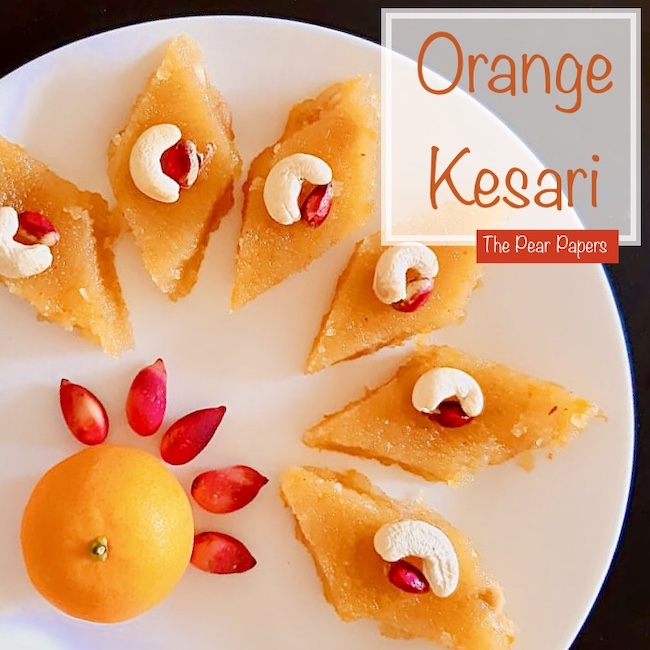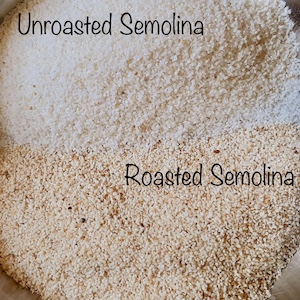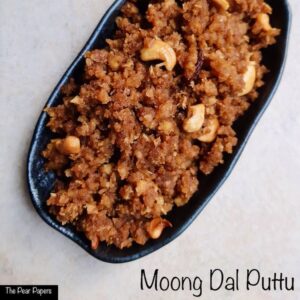
Orange Kesari
Kesari is a very simple, Indian sweet dish made of semolina, sugar and ghee. It is one of the dishes where a lot of improvisation and adaptations are possible. You can include any seasonal sweet, pulpy fruit or just add a lot of dry fruits to make it ‘Dry Fruit Kesari’. This Orange Kesari is an extended version of the traditional recipe, with the aroma of fresh, sweet mandarins.
In the olden days, there was a practice of making salty, crispy ‘Bajji’ and aromatic, cardamom flavoured Kesari, when two families meet for the first time to propose a marriage alliance. In fact, my mom also made Kesari and Bajji when my husband’s family first came to my house!
Though the process is simple and straight forward, there are couple of key points that can make or break your Kesari:
1. Carefully slow roasting the semolina until golden
2. Using aromatic home made ghee (check out my recipe to make home made ghee)
The above two are definitely the main things to take care of. The amount of sugar I’ve given in this recipe is perfect for me (I like my desserts to be nice and sweet). You can reduce 2 or 3 tbsp of sugar, if you prefer your Kesari to be moderately sweet. Go ahead and try this simple, yet deliciously interesting ‘Orange Kesari’ this festive season!
Ingredients
KESARI BASE:
Semolina (also called Rawa) – 1 cup
Sugar – 1 1/2 cups
Ghee – 1/2 cup
Cashews – 1/2 cup
Fresh/dried pistachios – 10 (for garnish)
Salt – a pinch
Boiling water – 2 to 2 1/4 cups
Orange essence – 1 tsp (optional)
ORANGE SAUCE:
Orange zest – 1 tbsp
Sugar – 1/2 cup
Fresh orange pulp – 1 cup
Fresh orange juice – 1/2 cup
Yield
20 pieces
Prep time
20 mins
Cook time
25 mins
Method
1) In a heavy bottomed pan, dry roast semolina (on low flame) until it mildly changes colour. Keep stirring continuously while roasting the semolina to avoid charring. As the grains of semolina are quite small, there is a chance that it might change colour quickly without getting roasted evenly inside-out. So keep the heat in minimum and dry roast patiently, because this is the key to a perfectly soft grainy kesari without any lumps. Transfer it to a plate and set aside.

2) In a saucepan, take all the ingredients given for the orange sauce and start heating it up on medium heat. Keep stirring continuously. After 2 mins the sugar will dissolve and start to boil. Allow it to boil for a further 6 to 7 mins, stirring constantly. Now the sauce will thicken slightly, and have a nice glazed look. Switch off the heat immediately and set the sauce aside.
3) In the same pan in which you roasted the semolina, take a tablespoon of ghee and heat it up. Add the cashews and roast until slightly golden. With a slotted spoon remove the fried cashews from the ghee and set aside.
4) Now add 1 tbsp of ghee and the roasted semolina to the pan and saute it for 2 mins. Add salt to the roasted semolina. Mix once.
5) Now carefully add half of the boiling water, while constantly stirring. The water will get absorbed in a minute or two. Gradually add water in batches until the semolina is cooked fully, stirring continuously (you will need totally 2 cups and maybe 2 more tbsps of boiling water for 1 cup of semolina to cook).
6) Add 1 1/2 cups of sugar to this cooked semolina. Mix well. Add orange essence, if you are using it, and also the orange sauce. Mix well. Keep the heat in medium and mix constantly.
7) At this stage, gradually add the ghee. As you add the ghee, it will get absorbed in the Orange Kesari. Keep mixing for a further 5 mins. After 5 mins, the ghee you’ve added so far will start to ooze out from the sides of the Kesari. This is the right consistency for a perfect Kesari.
8) Immediately add the fried cashews and mix once. Switch off the heat. Your Orange Kesari is ready now. Transfer it to a greased plate and level it up. Garnish with fresh pistachios. Allow it to cool completely. Then cut the Orange Kesari into desired shapes and serve.
Notes
- As mentioned above, slow roasting of semolina until slightly golden is important. If semolina is not roasted properly, you will get a lot of lumps in the Kesari when you add sugar. These lumps not only reduce eye appeal, but will also ruin the entire taste and texture. If you keep the heat in high and roast, then semolina will not be roasted evenly and char very soon.
- I’ve used sweet mandarin orange in this recipe. Feel free to use any type of sweet orange, mandarin or tangerine instead. You can also use fruits like apples, pineapples, mango, banana or strawberries instead of oranges. The measurements remain the same. In that case, instead of orange zest, use flavouring essence according to the fruit you are using.
- Many Indian desserts require good quality, aromatic ghee. It is best to make your own ghee at home. Store bought ghee can in no way match the aroma, freshness or texture of homemade ghee.
- Any other dry nuts can be used instead of cashews or fresh pistachio.
- The orange sauce made for this Orange Kesari can be stored in the refrigerator for almost 2 months. You can use it as a spread for your toasts, or as a topping for cakes, cookies or ice cream.
- Kesari can be served without shaping it too. You can just scoop out the kesari in a blob and serve in a cup with some dry fruits.
- Kesari stays fresh for 1 day without refrigeration at room temperature. Beyond that, refrigerate for up to a week and warm it up a bit before serving.
Beginners’ tips
- Be careful while adding boiling water to the roasted semolina. If your pan is not big enough, then it might splash a bit. So use a long handled ladle to stir.
- Adding a pinch of salt to your sweet dishes, not only enhances the overall taste, but also highlights the sweetness of the dish.
- Semolina expands almost three times in volume after it gets cooked. So choose a pan accordingly.


You May Also Like

Chocolate Walnut Brownies (Egg-free)
May 23, 2021
No Bake Chocolate Biscuit Bars
March 5, 2023